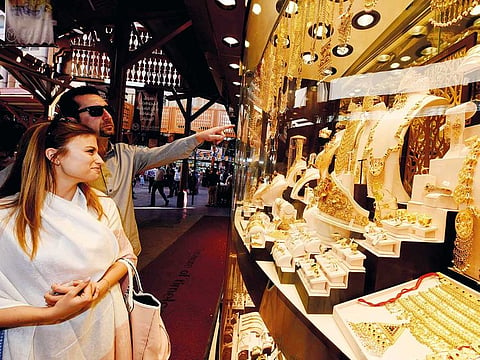Why are UAE shoppers staying away from gold?
With prices at Dh160 a gram and over, customers are unlikely to return in a hurry

Also In This Package
Dubai: Shoppers in the UAE are staying off gold as prices stick to levels well above Dh155 a gram. Even the much anticipated pick up in demand - even a slight one ahead of the summer breaks has failed to materialise.
Thursday’s opening price for 22k gold is Dh162.50, as per the Dubai Gold Rate, and local retailers are blaming it all on the price. “We are only seeing “desperate buying”, from those shoppers who are concerned that if they delay, prices might shoot up again,” said Cyriac Varghese, General Manager at Sky Jewellery. “But there haven’t been too many of these shoppers to generate volumes.
Prices will definitely head upwards until the reasons that led to the current surge subside … drastically. For now, how high will the upper limit go is the only question.

“There may be many technical reasons for international gold prices to have shot up - but that doesn’t mean much to consumers in the UAE.
“Prices will definitely head upwards until the reasons that led to the current surge subside… drastically. For now, how high will the upper limit go is the only question.”
It was in late June that local gold prices shot up past Dh160 a gram, a level which has always met with buyer resistance. More so, as for the better part of the last six years, these prices have stuck to around Dh140 a gram on average.
Global fears propel gold’s rise
Trade wars, tensions in the high seas around the Gulf, US interest rate cuts, dollar weakness and central banks’ buying binge - all these factors have contributed to international gold prices hitting a six-year high in recent weeks. During this period, gold “broke through $1,400 an ounce for the first time since 2013,” reports London-headquartered World Gold Council (WGC) in its latest quarterly update.
We will stick with the policy of having adequate inventory at all times. We have a brand image built over years — this helps us to move our own stock range.

“If for six years, gold prices were seeing mostly sideways trading at the $1,350 level, then going past $1,400 was enough to set off consumer jitters,” said John Mulligan, Head of Member and Market Relations at WGC. “That, in turn, has led led to the rapid and immediate dampening of buyer sentiments in some of the jewellery markets, including the Middle East.”
UAE gold activity subdued even otherwise
Even before the current upturn in prices, shoppers in the UAE were making less frequent visits to the jewellers. As per WGC estimates, jewellery demand in the UAE was down 5 per cent in the second quarter from a year ago, accounting for 9.3 tonnes. It compares poorly with the 15.5 tonnes sold in the first quarter of 2017. (But an improvement on the 6.9 tonnes recorded in the third quarter of 2018, which is the lowest in recent years.) On the price point, Mulligan does not hold out much hope for gold to reverse its gains and then head back to the more shopper-friendly levels of $1,350 an ounce… or even lower.
More uncertainty will keep gold on a high
“Geo-politics and trade fears will continue to play out through the year,” said Mulligan. “Gold will remain a strategic purchase for institutional funds and central banks as long as the heightened uncertainty remains.
“Institutional investors are looking at the risk spectrum and making a strong return to gold.”
If for six years, gold prices were seeing mostly sideways trading at the $1,350 level, then going past $1,400 was enough to set off consumer jitters.

True, if in June, funds - mostly those in Europe - picked up 67 tonnes, in July, their counterparts in the US led the way in buying 54 tonnes of the metal. With that kind of buying support, gold prices are sticking to $1,400 plus.
None of which is good news for UAE’s shoppers. For retailers, it means having to wait until shoppers start adjusting their minds to picking up gold for Dh155 a gram and higher.
UAE jewellers play the waiting game
Shoppers are unlikely to make a return unless prices drop significantly. But no one is betting on that to happen. “I feel we have to wait patiently for the market to swing back,” said Anil Dhanak, Managing Director at Kanz Jewels. “We will stick with the policy of having adequate inventory at all times. We have a brand image built over years - this helps us to move our own stock range.”
Even if local shoppers keep staying away, jewellers are hopeful that some buying will happen from tourists, especially those from India.
India’s import duty hike
Early in July, the Indian government raised the import duty on gold to 12.5 per cent from 10 per cent, which ensures that once again, prices in the UAE will become relatively cheaper than in India. From January 2018 onwards, UAE and India gold prices were roughly on par after the UAE introduced VAT and also charged duty on imported jewellery.
According to Varghese, “In India, the situation is going to get tougher - that’s perhaps a silver lining for jewellery retailers in the UAE. I would connect whatever momentum there is in the UAE market today due to the higher pricing in India.”
But WGC’s Mulligan reckons UAE jewellers should not put too much onus on this - “There will be some competitive pricing arbitrage. UAE retailers would benefit a little, but nothing particularly substantial.”
Who's buying
Gold prices at six-year highs may have put off shoppers, but others are hoarding up the metal.
Gold demand was 1,123 tonnes in the second quarter, up 8 per cent year-on-year, according to the World Gold Council. And that was enough for first-half 2019 demand to jump to a "three-year high of 2,181.7 tonnes, largely due to record-breaking central bank purchases".
Central banks acquired 224.4 tonnes in the second quarter and 374.1 tonnes in the first six months - "the largest net first-half increase in global gold reserves in our 19-year quarterly data series," the WGC report states.
Sign up for the Daily Briefing
Get the latest news and updates straight to your inbox





